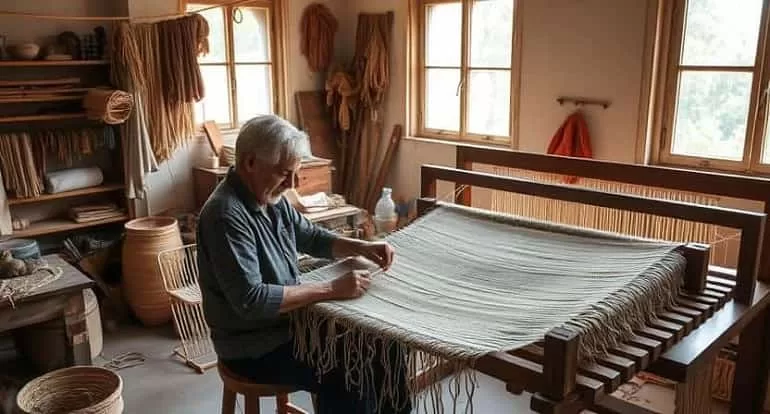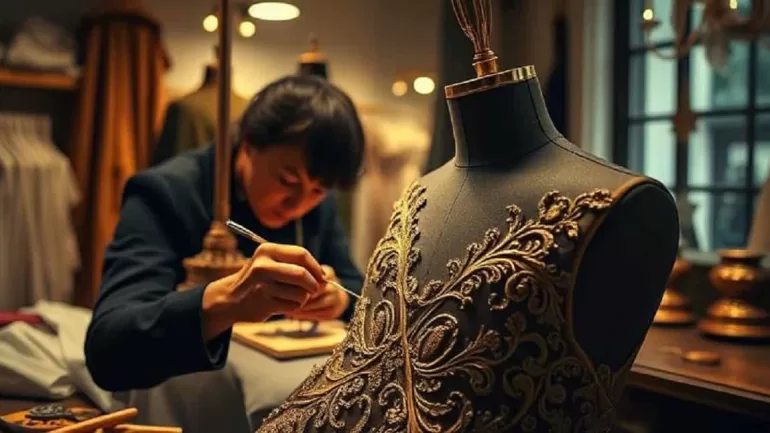LIFESTYLE
Many view handmade fashion as luxury. But is handcrafted fashion elitist, or can conscious consumers find ethical, unique styles at fair prices?
BY KAZEEM ADELEKE, ARTCENTRON
As consumers increasingly question the environmental and ethical costs of disposable apparel, handcrafted fashion has emerged not just as an alternative but as a compelling antidote to the relentless cycle of fast fashion. This burgeoning movement, celebrated for its inherent uniqueness, impressive artistry, and never-ending dedication to sustainability, beckons a deeper inquiry: In its quest for authenticity and ethical production, is handcrafted fashion inadvertently becoming an elitist pursuit? This complex query explores whether artisan fashion is truly accessible to all or if it predominantly caters to a privileged few.
Understanding Handcrafted Fashion: Beyond Mass Production
Handcrafted fashion refers to garments and accessories meticulously created by skilled artisans, often employing traditional techniques or manual methods. These unique fashion items are typically produced in small batches or as custom-made pieces tailored for individual buyers. In stark contrast to mass-produced clothing, handmade fashion prioritizes quality over quantity, deeply valuing craftsmanship, durability, sustainability, and rigorous ethical production standards.
This distinctive fashion segment frequently integrates a range of artisan techniques. They include hand-weaving, intricate embroidery, natural dyeing processes, and bespoke tailoring. Consequently, each handcrafted item possesses a truly distinct identity, carrying the story of its maker and materials. Related terms such as artisan fashion, handmade clothing, ethical fashion, slow fashion, and sustainable fashion are frequently used interchangeably to describe this movement. These labels collectively contribute to a growing global initiative that champions transparency in supply chains. It advocates for ethical sourcing of materials, fair trade practices, and long-term wearability, shifting focus away from transient trends and toward mindful consumption.
The Cost Factor: Discerning Price Versus Intrinsic Value
One of the most significant perceived barriers to the widespread accessibility of handcrafted fashion is its cost. Handmade clothing generally commands higher prices than its mass-produced alternatives, a reality largely attributable to the labor-intensive methods inherent in its production. The creation of each artisan piece demands considerable time, effort, and specialized expertise. Furthermore, these products often incorporate high-quality, ethically sourced materials, such as organic cotton, recycled fabrics, or natural fibers, which inherently contribute to a higher price point.
Crucially, the higher cost also reflects fair wages for artisans and adherence to ethical labor practices. Unlike the fast fashion industry, where labor is frequently underpaid and exploitative, handcrafted fashion strives to embody the true value of skilled work. While the premium price tag is often justifiable because of these factors, it undeniably restricts who can afford these unique fashion pieces. This economic divide gives rise to concerns about fashion elitism and whether handmade fashion can genuinely be inclusive. Key terms here include conscious consumerism, economic accessibility, and the cost of ethical production.
The Affordability Gap: Who Can Participate in Handmade Fashion?
Many consumers perceive handcrafted fashion as a luxury good, frequently associating it with designer brands and high-end boutiques. This widespread perception often fosters the impression that handmade clothing is exclusively for the affluent. While some handcrafted designer pieces, such as the iconic Hermès Birkin bag, are at the pinnacle of the luxury market due to their meticulous artisanal craftsmanship, premium materials, and rarity, it’s crucial to acknowledge that not all handmade fashion is prohibitively expensive. A vibrant ecosystem of independent artisans and small-scale businesses offers a diverse range of handmade garments at surprisingly accessible prices, challenging the notion of uniform high cost. You can find everything from intricately hand-embroidered blouses by global artisans sold directly online to locally crafted leather accessories from small urban studios or even thoughtfully designed and produced basics by ethical brands that prioritize fair wages and sustainable materials.
However, for a substantial segment of budget-conscious consumers, even modestly priced artisan fashion may remain financially out of reach. Fast fashion, with its significantly lower prices and broad availability, becomes the default choice despite its environmental and ethical downsides. This persistent affordability gap between handmade and mass-produced fashion continues to fuel the notion that handcrafted fashion is elitist. It reinforces a stark divide between conscious consumption and financial accessibility.
Commercial Luxury: Addressing Cultural Appropriation
A significant portion of handcrafted fashion has roots in traditional techniques and rich cultural heritage, particularly those originating from indigenous communities worldwide. These culturally significant garments transcend mere clothing; they embody generations of cultural identity, invaluable artisanal knowledge, and unparalleled craftsmanship.
However, a problematic trend emerges when large fashion houses or major brands adopt distinctive cultural styles without proper acknowledgment. They often fail to provide attribution or equitable compensation to the original creators. This practice, widely known as cultural appropriation in fashion, commodifies heritage fashion. As a result, it transforms cultural expression into a form of commercial luxury.
For instance, high-end collections often incorporate specific textile patterns or silhouettes from marginalized communities. Often, they use these elements without crediting or compensating the original artisans. This lackadaisical action disrespects their cultural legacy and monetizes their heritage for someone else’s profit.
Such exploitative appropriation reinforces fashion elitism. Moreover, it crystallizes the urgent need for more equitable practices and ethical collaborations in the fashion industry. Addressing this issue requires a commitment to cultural sensitivity. It also calls for respect for intellectual property rights and the empowerment of communities within the sustainable fashion movement.
The Digital Shift: Enhancing Accessibility Through E-commerce
The digital revolution has played a fundamental role in significantly improving the accessibility of handcrafted fashion. Through robust e-commerce platforms, widespread social media marketing, and efficient direct-to-consumer (DTC) websites, artisans and small fashion brands can now effectively reach a truly global audience. Platforms like Etsy, Instagram, Shopify, and specialized online marketplaces for handmade goods have empowered independent designers to market and sell their unique creations without the traditional reliance on costly intermediaries or brick-and-mortar retail spaces.
This remarkable digital transformation has undeniably helped to democratize access to handmade clothing. Consumers from diverse socioeconomic backgrounds and geographical locations can now easily discover what they love. Also, they can directly purchase artisan fashion from its talented makers. While digital access itself is contingent on factors like internet connectivity and digital literacy, this shift significantly reduces the barriers traditionally associated with luxury fashion and exclusive boutique shopping. In this way, the internet has been instrumental in diminishing the perceived elitist image of handcrafted fashion. By promoting a much wider spectrum of price points, styles, and artisanal creators, they made handmade accessible. This fosters greater inclusivity and supports the growth of small businesses in fashion.
Can Handcrafted Fashion Be More Inclusive?

A skilled male artisan hand-weaving fabric on a traditional loom.
To genuinely combat fashion elitism, the handcrafted fashion industry must proactively work toward fostering greater inclusivity. One promising approach is the adoption of sliding scale pricing for select handmade items. This approach will allow customers to pay according to their financial means. This innovative model promotes both fairness and accessibility, particularly when applied to everyday wear rather than exclusive, high-end collections.
Meaningful collaborations between established designers and marginalized artisan communities can also significantly promote equity. By ensuring proper recognition, cultural respect, and equitable financial compensation, these partnerships help safeguard creators from exploitation and celebrate their traditional craftsmanship. Furthermore, targeted educational campaigns focused on the principles of slow fashion, sustainable practices, ethical consumption, and the true value of handmade goods can further bridge the gap between aspirational intentions and financial affordability. Understanding the journey of a garment, from fiber to finished product, can foster deeper appreciation and willingness to invest.
Another powerful avenue toward enhanced accessibility lies in open-source fashion patterns and do-it-yourself (DIY) tutorials. These resources empower individuals to actively participate in handmade fashion by learning to create their own garments and accessories. In doing so, they effectively demystify craftsmanship. They will foster creative self-expression and invite a broader demographic to engage with the values underpinning handcrafted fashion. Above all, they will encourage skill-sharing and community building. This opportunity also ties into the growing repair and upcycling culture, extending the life of existing garments and reducing waste.
Is Handcrafted Fashion Elitist?
So, to directly address the core question: Is handcrafted fashion elitist? In certain significant respects, yes, it can appear to be. The often higher cost of handmade items, associated luxury branding, and instances of cultural appropriation can indeed reinforce a perception of exclusivity. However, it is crucial to recognize that these issues are not inherent flaws within the craft itself. Rather, they largely stem from how the fashion industry currently markets, distributes, and assigns value to handcrafted goods. The question of is handcrafted fashion elitist is nuanced and depends on how the industry evolves.
With intentional and collective action, there is the immense potential to redefine handmade fashion. It can evolve into a truly inclusive, community-driven movement that passionately supports artisans and celebrates diverse cultures, one that rigorously promotes environmental sustainability. By actively shifting the dominant narrative from one of exclusive luxury to one rooted in value-based consumption, we can cultivate an equitable space for everyone to participate regardless of their income or social status. Imagine a future where certifications like Fair Trade become commonplace for handcrafted goods, guiding consumers toward truly ethical choices. This transformation will decide whether handcrafted fashion is elitist or truly for all.
Ultimately, handcrafted fashion should be a powerful reflection of ethical values, not merely an indicator of social status. Its notable essence lies in honoring timeless tradition, meticulous craftsmanship, and mindful production. Making it truly accessible is more than an economic challenge; it is, at its core, a moral imperative for the future of fashion.
